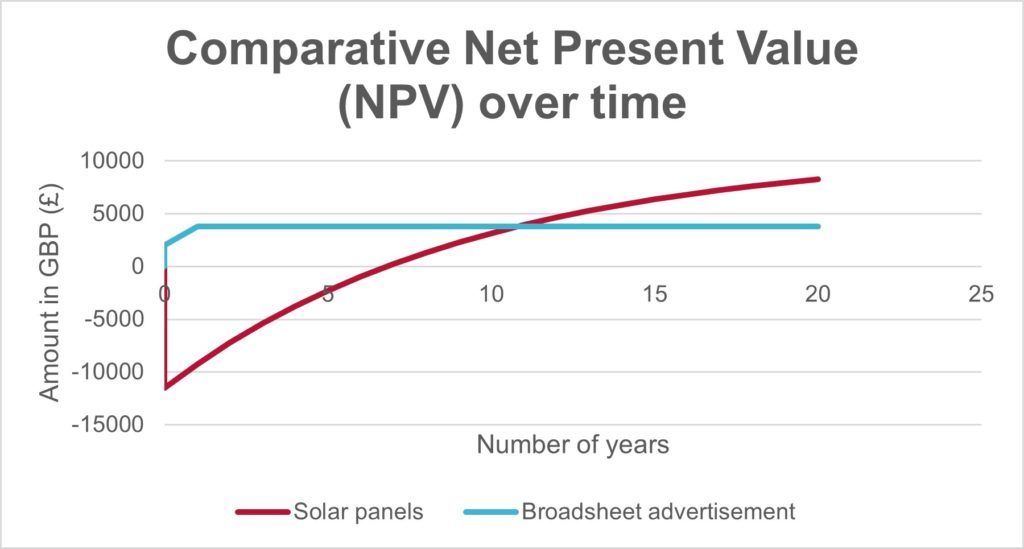
Writing for Defence Online, Howard Lungley, Sustainability Lead at Frazer-Nash Consultancy, proposes that defence’s drive towards decarbonisation offers it exciting opportunities for innovation.
Decarbonisation will, over the next few decades, be the biggest driver of technology the world has ever seen. For the Ministry of Defence, a focus on the future horizon will be essential if it is to benefit from new technologies.
The world is moving faster and faster. It used to be possible to keep up with current affairs, technology developments and maybe even have time to read a book. But with so many advances in scientific technology, it’s now almost impossible to keep pace. And this poses a major challenge for a sector such as defence, which needs to be at the forefront of change to ensure its essential tools are fit for purpose. There are major risks in failing to keep up with technological advances: from the spiralling costs of maintaining legacy assets, to less-effective responses to threat actors, to the loss of Britain’s reputation on the world stage.
Compounding this challenge is the fact that we’re at a tipping point, where environmental imperatives are shaping technology. We have just ten years to halve global emissions1 and, rather like turning a big tanker around, it’s not something you can do just overnight. The steps we’re taking towards net zero are going to change everything: the vehicles we drive, the way in which we work, even the ways in which we communicate with people.
Decarbonisation as a driver of opportunity
What’s becoming apparent, however, is that the Ministry of Defence needs to embrace decarbonisation, because over the next few decades it is going to be the biggest driver of technology that we’ve ever seen. There are huge opportunities for defence in taking advantage of the next generation of technology. It can enable improved capabilities, improved efficiencies and even improved competitiveness. If you’re getting a brand-new low-carbon vehicle, for example, you’re not just getting a low-carbon vehicle, you’re getting a new vehicle. By the very fact that manufacturers have learnt from past vehicles, and understand what changes are needed to make them better, the new generation will offer enhancements and improvements. Electric vehicles, for example, including electric drones, have a reduced noise profile, so could potentially benefit surveillance activities; while sustainably produced hydrogen could not only drive naval ships, but the surplus energy produced could be used to power equipment at dockyards and ports.
Solar, wind, tidal and other generation sources, with their low carbon emissions, will contribute to defence decarbonisation and could potentially help to deliver self-sufficient remote bases. The energy these technologies produce could be used to power water filtration and food production systems, and even to recycle and repurpose waste materials into new products using 3D printing. With a huge supply chain geared towards supplying diesel to remote bases at present, sometimes via very difficult supply routes, using renewable technologies would not only remove those involved in that supply chain from danger, but also reduce the risk of the base’s energy supply being cut off.
Breaking down siloes
But to get ahead of the game – and even just to keep up – all organisations, including the Ministry of Defence, are continually going to have to horizon-scan. They will need to actively look at how environmental issues will lead to global shifts, both for humanity and for their organisation, including the potential impacts of climate change; and they will need to equally actively make the changes essential to meet these challenges. By scanning for new environmental technology options, and pursuing its interest, influence and investment in those that could provide novel future capability (and help meet sustainability goals), defence will ensure that it maximises the forces’ potential.
In this evolving world though, using the same old methods just isn’t going to work, so defence will need to break down any siloed structures separating its pools of knowledge internally, and draw on best practice from across and outside its domain. Siloes, and barriers to sharing knowledge and making decisions, will slow the forces down, at a time when they need to be taking action quickly. A huge culture change will be required to meet defence’s decarbonisation ambitions, and its current siloed nature will stand in the way of progress. Just as the army’s digital transformation programme, THEIA, is aiming to change culture and behaviours around digitisation, a cross-forces commitment to working together to solve the challenges of climate is essential. It’s time to re-engineer the defence siloes into a modern and agile workforce that can learn, adapt and be proactive in addressing the future problems it faces. Central to this change, of course, are people, so mapping key stakeholders across all sectors of defence, and their role in the wider system and organisation, could help identify the barriers and enablers to success. Only by bringing everyone along on the journey will MOD deliver long-lasting behavioural change. In this mission, there’s no alternative but to be on the front foot.
Innovation, of course, does come with inherent risks. So, how can defence leaders ensure they are making the right decision at the right time? Well, the military invented the notion of scenario planning, and it’s an approach that can work just as well in the mission for decarbonisation as on the battleground. There are going to be many possible futures: using scenario planning will enable defence to envisage a whole range of potential future technological solutions to decarbonisation, be they sustainable fuels like hydrogen, reduction strategies like carbon capture, or novel generation technologies, such as space solar power.
Whilst many factors may combine in complex ways to create sometime surprising futures (due to non-linear feedback loops), systems thinking can be used in conjunction with scenario planning to demonstrate the causal relationship between factors, and to arrive at plausible story lines. Modelling and simulation offer a powerful addition to scenario planning, by providing a way to ‘game’ the future scenarios and uncover any unintended consequences of potential strategies. By simulating and modelling the consequences that could arise from taking different actions within scenarios, defence leaders will be empowered to make decisions today, and tomorrow, that are robust to many uncertain futures.
Following fast
While scenario planning can help the sector to understand the outcomes of a range of decisions, it’s not enough to decide what kinds of technology defence is likely to choose, and then wait for those to be ready for adoption. To be an ‘early adopter’ or a ‘fast follower’ isn’t a passive experience – you can’t just stand still and wait. The forces will have to work hard to ensure their organisations are ready for the new technology. If a defence force wanted to roll out a fleet of electric vehicles – tanks for example – it could take two years or longer before suitable vehicles could be developed to meet its needs. Those two years will be essential though, to put in the effort to get the organisation ready to adopt them – changing internal processes, planning infrastructure changes, and ensuring stakeholder buy-in is gained. Rather than starting the journey later, defence needs to get ready so there is no delay in adopting technology as soon as it becomes available.
In effect, it is less about ‘technology readiness’, which is used to define how mature a new technology is, it is more about how mature the organisation is, in readiness for the new technology. Defence already needs to be on the cutting-edge for its equipment, information-gathering and weaponry – now it needs to extend that readiness for innovation out into a much broader field: to ask questions like, ‘how do we heat our buildings sustainably?’ and ‘how do we decarbonise our means of moving around the training estate?’.
Policy for the longer-term
The UK government has set very ambitious decarbonisation targets: both Net Zero 2050 and the interim target for a reduction in emissions by 78% by 2035. With the launch of its 10-point plan, it is now more likely to introduce policies that will incentivise low carbon technology, and disincentivise carbon consumption. So, a base’s wind turbine or solar panels could potentially benefit from new economic policies on taxation, or grants; while carbon-intensive, diesel-using technologies might even be penalised. Just as with scenario planning however, government will need to make sure that any policy that it creates around decarbonisation is evidence-based and data driven and that it doesn’t have unintended consequences – and this can be where policy sometimes falls short. Again, modelling and simulation can offer a cost-effective solution to help government assess the impact of its proposed policies. These tools can be used to help government to optimise the combination and timings of its investments (real options analysis), to visualise the best solution, and to produce an evidence base to demonstrate it can effectively deliver its planned aims.
With finite budgets, cost will always be a consideration for the defence sector. But while the initial outlay to deliver decarbonisation will require a degree of capital investment, defence needs to avoid adopting a short-term mindset. If the payback period of a solar installation, for example, is seven years, a short-term view may see that as too long, and choose instead to invest in projects with a payback of two years. But comparing the lifetime cost of the projects, by the organisation generating its own energy in the long-term, the solar installation could pay back much more over a longer period. (As in the example at Figure 1, below, which compares investment in a broadsheet advertisement against solar panels.)

With decarbonisation a critical mission, for both the forces and for the planet, defence will need to ensure it keeps a focus on the net zero future horizon. But as it prepares for and adopts technologies that enhance its capabilities, it will reap many benefits along the way.
If you would like to join our community and read more articles like this then please click here







